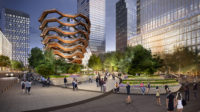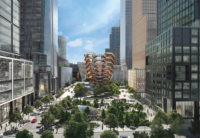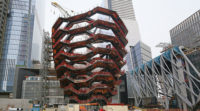With projects under way from Tennessee to Tasmania, landscape architect Thomas Woltz, FASLA, and his firm, Nelson Byrd Woltz, work at the intersection of the natural and built environment. One of the practice’s highest-profile commissions of late—New York’s Hudson Yards development, on the far west side of Manhattan—has quite literally elevated the challenge of creating a beautiful, healthy ecosystem in a major urban area: the five-acre plaza and garden sit on a deck atop a functioning rail yard.
Just before the opening of Hudson Yards, RECORD spoke with Woltz by phone as he traveled along the Pacific Coast Highway, from Malibu to Los Angeles, to catch a flight to Houston, where his firm is working on Memorial Park.
With Hudson Yards officially open, what lies ahead for your firm with this project?
The plaza is complete, and the landscape will continue to evolve and grow with the seasons. We will be planting through the spring and summer. Big trees, for instance, can’t be dug and craned in during February and March because of the freezing temperatures.
Right—I recently tried to plant some window boxes and discovered all my dirt was frozen.
You know what? Hudson Yards is really not unlike your window box. You have soil in a suspended box that can freeze on all sides, unlike the earth, which has natural insulation. Hudson Yards is similarly vulnerable from all sides, because it’s a constructed box of soil, with water, sewage, and high voltage electricity in it as well. Imagine if all of the utilities of your apartment ran through your window box. Also, nothing is on the ground; the trains, just like the street below your window, are moving, and you can’t drop anything out of your window box into that street. I hadn’t thought about this before, but your window box is actually the perfect analogy.
Have you met your own goals for the project?
I feel like we have been able to achieve the vast majority of what we set out to do: to make a beautiful, hospitable place for the people of New York. This is the part of Hudson Yards where you don’t pay an admission fee; you don’t have to buy anything to enjoy the plaza and gardens. I’m very proud of the fact that we are making a civic space for the next century. When you think on the term of a hundred years, you think about public space differently, and that shift in thinking affects how you build. For example, our deep investment in the structures below grade will allow the large trees to get to full maturity.
How does your design anticipate the growth of both plants and buildings in such a rapidly changing neighborhood?
Because the skyscrapers cast so much shade, we looked to the native forest ecology of the Hudson Valley, where there’s a really beautiful, diverse, and resilient plant community that thrives in our climate.
We’ve relied heavily on the ornamental qualities of native plants, and I think people will be rewarded for paying attention with subtle surprises, like tiny, ephemeral lilies in the spring and bright red twig dogwood in the winter. There will be no purple cabbages—no shopping mall plants.
What are the next steps?
The trees in the plaza were planted last summer and will be breaking bud in the spring. In April, the large trees in the north garden will be craned in. You want to plant them while they’re still dormant so that they wake up in their new environment. Next, we’ll come in with shrubs; then, when it’s warmer, the perennials, and bulbs again in the fall.
Your firm has been engaged with Hudson Yards since 2012. What is the value in being part of the team from so early on?
We have had a major role in coordination of all the engineering decisions related to drainage, retention of stormwater, and structural considerations, so that the final design maintains its integrity. It’s been really interesting for our firm to participate in that, and I think it helps debunk the myth that the landscape architect comes in with a truck of plants at the end of the project and makes it look pretty. No—the design of the space comes first, and that gets back to the very first point of making a welcoming environment for the public. Tens of thousands of people will visit and observe this site from above, and we want them to be dazzled by the harmony of the design.





Post a comment to this article
Report Abusive Comment